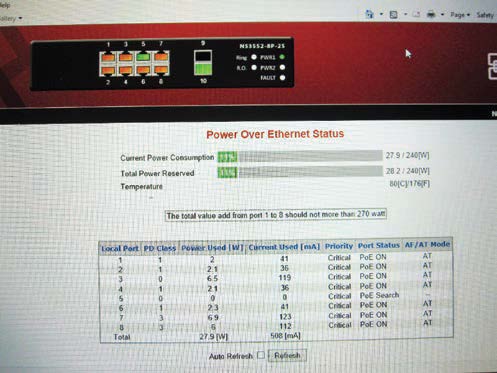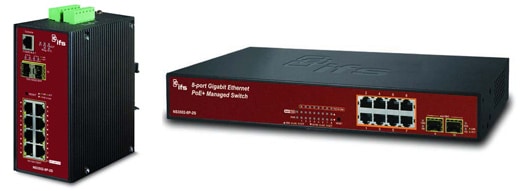Over the past several years the use of cameras and other components with Power over Ethernet (PoE) capabilities has expanded greatly in the CCTV field. This has led manufacturers of network switches to expand their offerings to include new switches with PoE options. Interlogix, a division of UTC, has an expanded product line that includes unmanaged and managed network switches with PoE options. This review covers two of those switches, the IFS NS3502-8P-2S and IFS NS3552-8P-2S. Both provide myriad programming functionalities and would make any IT person giddy with the available system options. That said, we’ll focus on the options and programming that will most benefit CCTV integrators utilizing these products in the real world.
Construction
Both switches are solidly constructed units with metal enclosures. The NS3502-8P-2S is 1.75 inches (1RU) in height and is designed to be used as a standalone switch utilizing rubber feet (included) or rack mounted with the supplied rack mount ears. Our demo unit was supplied with a 110VAC power cord but the unit is designed for world use with its operating voltage range of 100-240VAC and 50/60Hz. This model is designed for operating temperatures between 0⁰ C to 50⁰ C and also ships with a DB9 to RJ45 RS232 patch cable to allow those diehard programmers to perform command line interface (CLI) programming. The NS3552-8P-2S is the heavy-duty cousin of the NS3502- 8P-2S. While sharing many program design features, the former is designed for much harsher environments. The NS3552-8P-2S has a modular design and can be mounted directly to a wall with its supplied brackets or to a top-hat DIN rail mount in an appropriate enclosure. This model has a heavy cast metal case with heat sinks incorporated to both sides of the module to dissipate heat during operation.
The NS-3552-8P-2S utilizes a separate redundant output power supply to give it additional power capabilities for the unit’s attached components. The switch’s operating temperature range is expanded to -40⁰ C to 75⁰ C and is built
to comply with IEC60068-2- xx standards for vibration and shock. These specifications allow the NS3552-8P-2S to be used in applications such as warehouses and roadside enclosures, and generally withstand the wrath of unforgiving conditions in the real world. This model is also designed to resist interference from electromagnetic (EMI) and radio-frequency (RFI) sources typically found in industrial environments.
The PS48VDC480W-DIN power supply for the NS3552-8P-2S has dual 48VDC outputs for connection to the network switch. The power module is also designed for top-hat DIN rail mounting next to the NS3552. The power supply is designed to be used with 100-240VAC 50/60Hz and has a three-lug power input connection to accommodate installation in a structured environment.
Features
The NS3502-8P-2S and NS3552-8P-2S network switches both feature eight 10/100/1,000Mbps PoE+ Ethernet ports, two 10/100/1,000Mbps small form factor pluggable (SFP) ports and one RJ45 console port for use with the supplied RS232 cable. The NS3502 can accommodate up to eight IEEE 802.3af PoE devices (15.4W each) or it can power five IEEE 802.3at PoE+ devices (30W each). The NS3552
model has the additional capacity to accommodate up to eight IEEE 802.3at PoE+ devices (30W each). The two SFP ports on both models can accommodate a range of GIBC adapters and are compatible with single mode and multimode fiber installations.
Of interest to the CCTV world is the powered device (PD) monitoring feature that both models offer. Through the PD feature of both switches, all attached cameras/devices can be monitored through the PoE ports in use and, should one of the attached cameras/devices stop responding to a system ping, the managed switch will cycle power to that PoE port and effectively reboot the camera or attached device. This can be a labor-saving feature for any installation and potentially save system downtime for field components.
Setup
Not being much of a managed switch guy I was initially hesitant when I opened the box for the NS3502-8P-2S and saw the DB9 to RJ45 serial cable. I was even more hesitant when I started reading the quick setup guide, which begins with connecting a Hyper Terminal session using the RS232 interface of the NS3502. Suffice it to say I was relieved when I found the Web browser-based section of the quick installation guide. All the IFS network switches (and I thank them for this) are configured from the factory with a default IP address, and user name and password for ease of access. This uniformity in design makes it easy for a technician when programming multiple switches for a location. I accessed the system menu and set the NS-3502’s IP address to match my test NVR system’s IP schema. All of the basic programming was easy to conduct and the system parameters were easy to figure out without having to utilize any help documents.

All IFS network switches are configured from the factory with a default IP address, and user name and password for ease of access. This simplifies basic programming and system parameters.
Testing
For my testing I wanted to set up each switch like it was a field node in a CCTV system. To do this I connected seven PoE fixed cameras to the NS3502’s front mounted PoE ports. Five of these cameras were Axis 216FD fixed cameras and the other two were ACTi TCM7411 megapixel cameras. I connected the NS3502 to my local test network with a Cat-5 cable through the last PoE port. I also wanted to test the SFP port’s operation so I utilized a GBIC single mode adapter in one of the two SFP ports. I routed the single mode fiber connection to my laptop via a fiber/Ethernet media converter to complete the test setup. Following the camera connections I went into my local test NVR and added the seven IP cameras that I had connected to the NS3502-8P-2S. I made sure that I programmed each camera’s recording rate to 30ips for the testing and set the image quality to high for each camera. Following this I accessed my NVR program and observed the video for my test cameras. Each camera was streaming video to my NVR with great quality and I did not notice any drop-offs during my testing.
I removed the NS3502-8P-2S from my test setup and made the same connections with the NS3552-8P-2S to see if I would get the same performance characteristics. The NS3552 performed as well as the NS3502 had during my system testing. The on-screen system menus provided specific information regarding the switch’s status and operating parameters. I especially liked the PoE status menu that showed me how much (or in this case how little!) power my cameras were drawing from the switch. As you can see from the screen shot above, the NS3552-8P-2S wasn’t even breaking a sweat with my test setup.
I did locate the menu screen where I could set the power state for each PoE port so I played around, turning off several of ports’ power with ease. This can be very helpful for troubleshooting in the field or when a camera needs to be reset.
Scrolling through all the configuration menus for the NS3502 and NS3552 was, to be honest, a bit daunting. In my opinion there are probably five-10 menu screens that the average CCTV integrator will utilize for a system installation. That doesn’t mean there isn’t some clever installer out there that will relish in all of the capabilities that these switches possess and will spend hours playing with the settings!
Conclusions
The NS3502-8P-2S and NS3552-8P-2S could just be the workhorse needed for a given CCTV project. The PoE capability (especially the NS3552) is a winner when it comes to implementing IP cameras in a new or retrofit CCTV system.
Verdict
- Features 1 2 3 4 5
- Construction 1 2 3 4 5
- Setup 1 2 3 4 5
- Performance 1 2 3 4 5
- Overall 1 2 3 4 5
First published in the July 2014 issue of Security Sales & Integration magazine.




